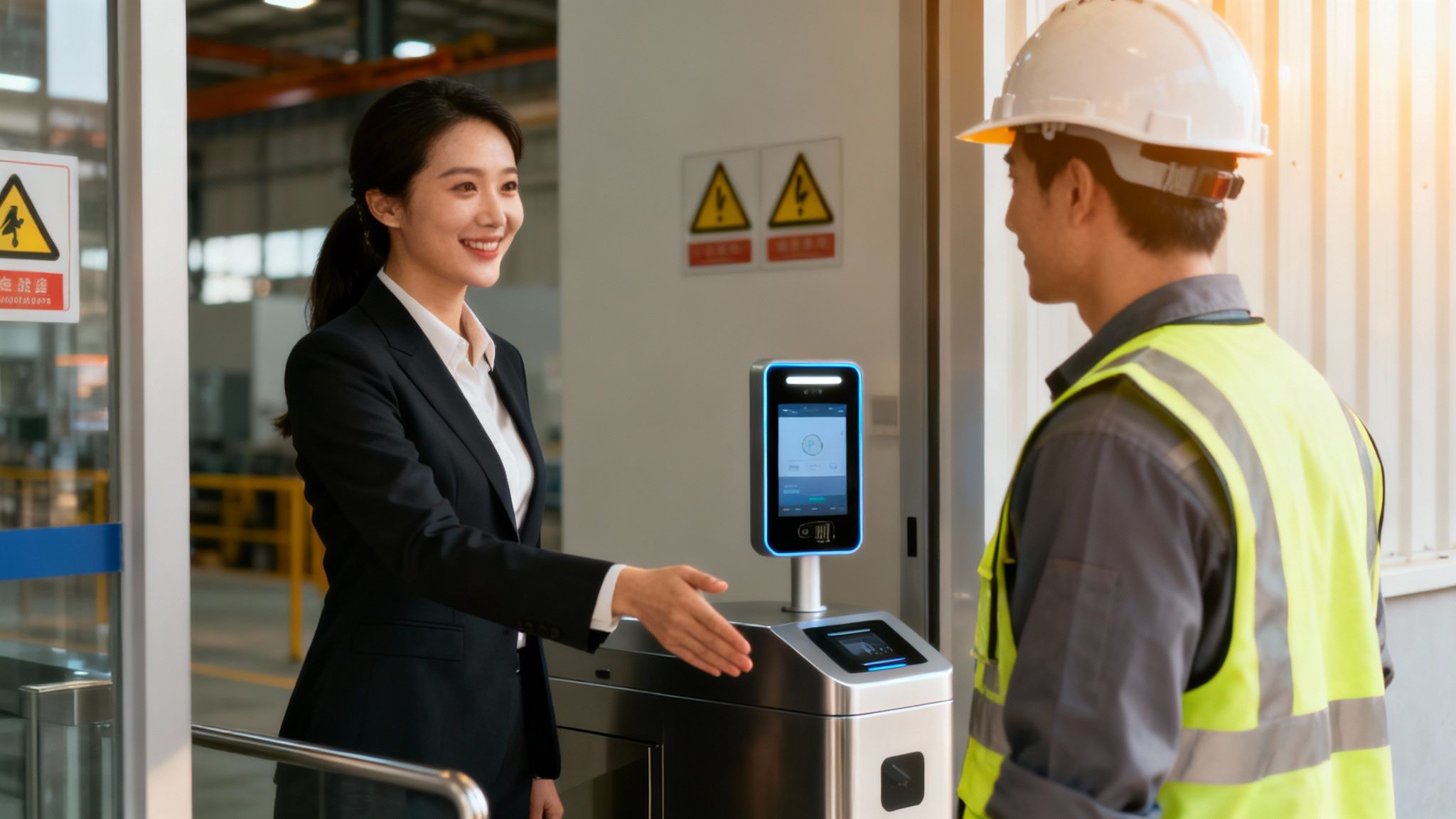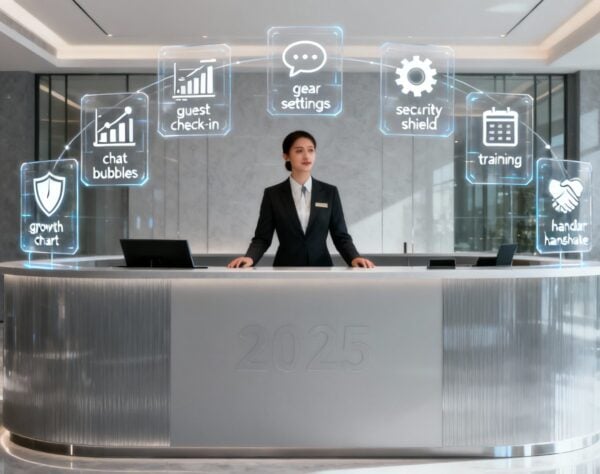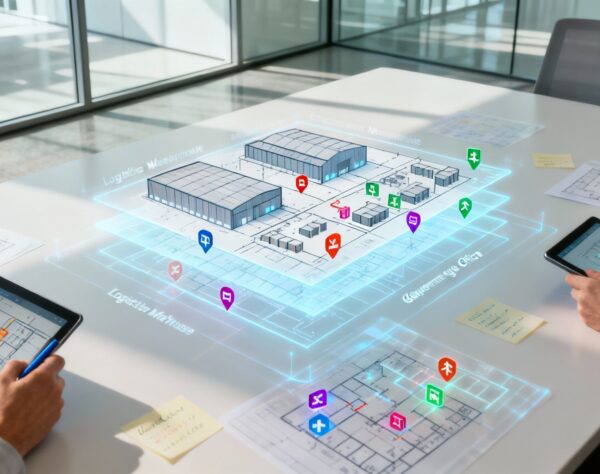
Why Safety in the Workplace Is Important for Your Business
Workplace safety is more than a compliance checklist; it’s the foundation of a healthy, productive, and resilient business. A strong safety strategy protects your most valuable asset—your people—while shielding your bottom line and reputation. Ignoring safety leaves the door wide open for risks that can destabilise your entire operation.
The Four Pillars of Workplace Safety
So, why is workplace safety so critical? It rests on four interconnected pillars that protect your people, profits, and public perception. A robust safety strategy helps a business thrive, while a weak approach invites preventable disasters with staggering human and financial costs.
For context, consider this: the Australian workplace fatality rate was recently 1.3 deaths per 100,000 workers, representing 188 lives lost in a single year. These aren’t just numbers; they are a stark reminder of the constant need for strong safety measures. You can dive deeper into these national work health and safety statistics to get the full picture.
The importance of workplace safety becomes clear when you see how these four pillars support each other. Far from being an expense, prioritising safety is an investment that pays real dividends.
| Pillar | Impact on Your Business |
|---|---|
| People | First and foremost, safety prevents injuries and saves lives. A secure workplace builds trust and boosts morale, leading to a more engaged and productive team. |
| Profit | Fewer accidents mean fewer costs from workers’ compensation claims, legal fees, and operational downtime. A strong safety record can also lead to lower insurance premiums. |
| Perception | A genuine commitment to safety builds a powerful brand image. It helps attract top talent, earns customer loyalty, and demonstrates operational excellence. |
| Compliance | Meeting legal WHS/OH&S obligations is about upholding your duty of care, protecting your business from fines and legal action. |
As you can see, these pillars are all linked. A safe team is a productive team, which protects your profits and enhances your reputation, all while keeping you on the right side of the law.
How a Visitor Management System Fits In
You can’t have a secure site if you don’t know who is on it. A modern visitor management system provides a crucial first line of defence. Your business benefits by ensuring everyone—from contractors to clients—is accounted for and understands your safety protocols before they step past reception. This is foundational to maintaining a truly safe and compliant workplace.
Understanding the True Human Cost of Accidents
When a workplace incident occurs, it’s easy to focus on the numbers—financial reports, insurance claims, and lost time statistics. But behind every figure is a real person whose life can be turned upside down in an instant.
We often think of major accidents, but common, seemingly minor incidents can be just as devastating. A simple slip can lead to years of chronic pain. A repetitive task could result in long-term musculoskeletal damage. These injuries don’t just stop someone from working; they impact their mental health, family stability, and overall quality of life. Each incident, no matter how small, is a moment where a safety process failed someone.
Beyond the Headlines: The Reality of Workplace Injuries
While fatalities rightly grab headlines, understanding the importance of workplace safety means looking at the full picture. In Australia, the most frequent compensable incidents are not dramatic events but injuries from everyday hazards.
According to Safe Work Australia, musculoskeletal injuries—like strains and sprains from repetitive motions—have consistently been the number one reason for claims over the last decade, closely followed by slips, trips, and falls.
These incidents create a ripple effect, causing lasting physical and psychological pain that follows people home long after their shift ends. This highlights the core moral obligation of every business: to ensure every team member gets home safely each day.
Protecting Everyone on Your Premises
This duty of care extends to every person on your site, including contractors, clients, and visitors, who are all exposed to the same potential hazards.
A visitor management system helps you meet this responsibility. By ensuring every person is accounted for and briefed on safety protocols upon arrival, you build a genuine culture of safety. This shows everyone—employee or visitor—that their wellbeing is your top priority. For specialised environments, a detailed manufacturing safety audit checklist or WHS assessment can be a game-changer for identifying and mitigating risks before they cause harm.
Meeting Your Legal and Financial Obligations
Ignoring workplace safety is a massive financial and legal gamble. Australian law is clear: businesses have a non-negotiable duty of care to keep workers and site visitors safe. The penalties for non-compliance are severe, ranging from heavy fines to legal battles that damage your company’s reputation.
But direct penalties are just the tip of the iceberg. The hidden costs often do the most damage: skyrocketing insurance premiums, the expense of recruiting and training replacements, and lost productivity from operational downtime. A single serious accident can trigger a chain reaction of financial pressures. This is exactly why safety in the workplace is important for long-term survival.
Protecting Your Bottom Line Proactively
Viewing safety as an expense is a dangerous myth. It’s a core risk management strategy and a direct investment in your business’s financial health.
By preventing incidents, you actively protect assets, maintain smooth operations, and shield your company from the immense financial fallout of an accident. It’s about building resilience directly into your business model.
A modern visitor management system provides immediate benefits here. It gives you a clear, time-stamped record of everyone on-site and guarantees that all contractors and visitors complete safety inductions before starting work. This systematic approach strengthens your liability defence and demonstrates a serious commitment to legal compliance. Automating these checks helps you create a secure environment, which is the cornerstone of solid compliance in the workplace.
How a Strong Safety Culture Drives Profitability
Viewing workplace safety as a cost is an outdated perspective. A strong safety culture is a powerful engine for growth, directly boosting your bottom line by fostering a more engaged, loyal, and productive team.
When employees feel safe and valued, their performance soars. It’s no surprise that companies with high employee engagement report 23% higher profitability than those with disengaged teams. This isn’t just about feeling good; it’s about creating an environment where people can focus on their best work without fearing injury.
From Reduced Costs to Increased Efficiency
A proactive safety culture is brilliant at cutting costly disruptions. Every accident, no matter how small, leads to downtime, potential equipment damage, and paperwork that erodes profits.
By preventing these incidents, you maintain a steady workflow and reduce expensive employee turnover. This commitment to safety also becomes a competitive advantage, helping you attract top talent and build trust with clients who prefer to partner with responsible businesses.
A safe workplace is an efficient one. When processes are designed with human wellbeing in mind, they are often smoother and more effective, directly contributing to better business outcomes.
The Role of Smart Systems
Investing in tools that reinforce this culture delivers tangible returns. For instance, a visitor management system offers benefits beyond simple tracking; it ensures every contractor and visitor completes mandatory safety inductions before entering your site.
This automation tightens compliance and sends a clear message that you are serious about everyone’s safety. By streamlining these crucial checks, you can learn how to improve operational efficiency while building a safer, more profitable business.
Strengthening Site Safety and Compliance
Demonstrating a true commitment to safety is about taking consistent, tangible actions to protect everyone who enters your premises. A modern visitor management system is one of the most powerful tools for this. It’s a huge leap from paper logbooks, providing an instant, accurate digital record of everyone on-site—a critical advantage during an emergency evacuation where every second counts.
More importantly, it closes dangerous gaps. A sobering 64% of contractors admit they would skip safety protocols if they thought they could get away with it. An automated system eliminates this risk by making safety inductions mandatory for every visitor and contractor before they can begin work.
Automating for a Safer Environment
This automation is fundamental to strengthening legal compliance and reducing risk. It creates a clear, auditable trail proving you have taken all reasonable steps to inform people of site-specific hazards. Adhering to guidelines like indoor environmental quality standards is just one piece of this bigger picture.
Systematising these safety steps provides several key benefits:
- Instant Verification: Gain immediate proof that every person on-site has completed the necessary safety training and acknowledged hazards.
- Emergency Readiness: In an evacuation, you have a real-time list of everyone present for a fast and accurate headcount.
- Consistent Compliance: Ensure every person receives the same, up-to-date safety information, eliminating human error and guaranteeing consistency.
Ultimately, this proactive approach does more than tick boxes. It sends a powerful message to employees, contractors, and visitors that their safety is your organisation’s top priority. That’s how you build trust and foster a genuine safety culture.
Actionable Steps for Building a Safer Workplace
Creating a culture where safety is second nature is an ongoing commitment built on practical, consistent actions. The journey starts with a simple idea: make safety visible, obvious, and easy for everyone to participate in.
A great first step is to conduct regular, thorough risk assessments. This isn’t just about spotting a frayed cable; it’s about examining every process and asking, “How could someone get hurt here?” Involving your team is crucial—they are on the ground and often have the best insights into day-to-day hazards.
Foster Open Communication and Continuous Learning
A safer workplace thrives on open dialogue. Your team must feel empowered to report hazards or near-misses without fear of blame. Studies repeatedly show that psychological safety—the belief you won’t be punished for speaking up—is a key ingredient for any high-performing team. When people feel safe to contribute, they become your most effective safety advocates.
This culture of openness must be backed by continuous learning. Move beyond dry lectures for safety training. Adopting effective methods like interactive training is key to keeping people engaged and ensuring knowledge sticks.
Building a truly safe workplace means creating an environment where asking for help is encouraged, admitting mistakes is a learning opportunity, and every voice is heard. This shifts safety from a top-down mandate to a shared responsibility.
Equip Your Team with the Right Tools
Finally, support your safety goals by investing in tools that make safe practices easier. Modern systems shine here, automating critical checks and providing a clear, auditable trail of your safety efforts.
A visitor management system offers several benefits to strengthen your safety framework:
- Standardising Inductions: It ensures every contractor and visitor receives the same up-to-date safety briefing before entering your site.
- Improving Emergency Response: In a crisis, you gain an accurate, real-time list of everyone on-site, which is vital for evacuations. Use an emergency response plan template to structure your procedures.
- Demonstrating Due Diligence: You create a clear digital record proving you are actively managing site risks and meeting your legal obligations.
Your Workplace Safety Questions Answered
Let’s tackle some of the most common questions business leaders have about building and maintaining a strong safety culture.
What’s the single most important factor in creating a safe workplace?
While many elements are important, everything starts with strong leadership commitment. When senior management visibly champions and invests in safety, it sends a powerful message to the entire organisation. This top-down approach turns safety from a poster on the wall into a shared value.
How can I get employees to actually report safety concerns?
The key is creating a genuine no-blame reporting system. People won’t speak up if they fear getting in trouble. Your process must be easy, accessible, and confidential.
Most importantly, you have to publicly acknowledge and act on the feedback you receive. When your team sees their input leads to tangible improvements, it builds trust and encourages more proactive reporting.
Is workplace safety just for high-risk industries like construction?
Absolutely not. While a construction site has obvious dangers, an office environment has its own hazards. Ergonomic injuries from poor desk setups, electrical risks from faulty equipment, and even simple slips and falls can cause serious harm. Every workplace has a duty of care.
Ready to strengthen your site’s safety and compliance right from the front door? See how VisitUs creates a secure, welcoming experience for every person who walks onto your premises. Explore the benefits today.





